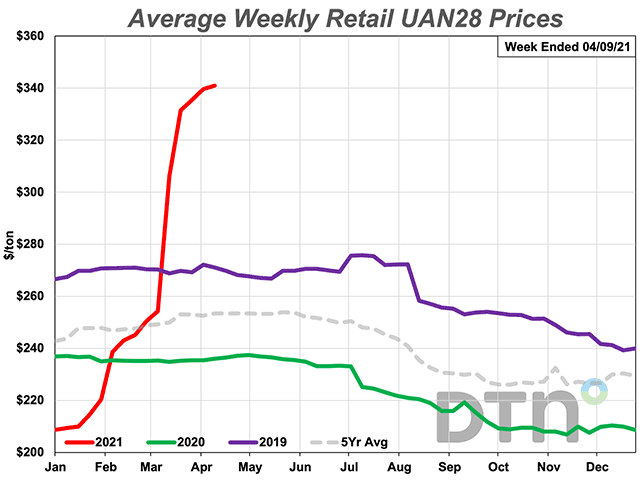DTN Retail Fertilizer Trends
Nitrogen Prices Continue to Climb as Other Fertilizer Price Gains Cool
OMAHA (DTN) -- Average retail fertilizer prices continued to move higher the first week of April 2021, albeit at a slower pace than in recent weeks, according to sellers surveyed by DTN. For the second week in a row, several fertilizers saw only a slight push higher.
While all eight of the major fertilizers were higher in price, only three fertilizers' prices continue to be significantly higher, which DTN designates as 5% or more.
Anhydrous and UAN28 are both 11% higher compared to last month. Anhydrous had an average price of $692 per ton while UAN28 is $341/ton.
Also considerably higher is UAN32, which was up 10% from the prior month. The liquid nitrogen's average price was $378/ton.
The remaining five fertilizers were higher once again but had price increases of 4% or less.
DAP had an average price of $618/ton, MAP $699/ton, potash $431/ton, urea $504/ton and 10-34-0 $605/ton.
P[L1] D[0x0] M[300x250] OOP[F] ADUNIT[] T[]
On a price per pound of nitrogen basis, the average urea price was at $0.55/lb.N, anhydrous $0.42/lb.N, UAN28 $0.61/lb.N and UAN32 $0.59/lb.N.
The rising retail fertilizer price environment has farmers wanting to be as efficient as possible when applying nutrients. A recent Penn State University (PSU) Extension article titled "Rising Fertilizer Prices Highlight Value of Soil Testing and Manure Nutrients" explores a couple ways to limit the impact of skyrocketing fertilizer prices.
Author Charles White, PSU assistant professor of soil fertility and nutrient management, wrote that soil testing is the traditional method of determining the availability of nutrient levels in relation to crop requirements. Soil tests are calibrated through field experimentation to determine at what level there are sufficient nutrients already in the soil to be able to meet the needs of a crop without additional fertilizer.
"This soil test level is called the 'critical level' and in the Penn State soil test interpretation categories (below optimum, optimum, above optimum), the critical level is at the bottom of the optimum range," White wrote.
The thought is to build soil test levels into the optimum range and maintain levels at this range by applying nutrients to match crop removal rates, he wrote. While this provides good economic returns in the long run, farmers can consider reducing fertilizer application rates for short periods of time due to cost or lack of availability if one follows the building components thanks to this buffer.
While you can't reduce fertilizer application rates forever, as soil test levels will fall below the critical level and yields will suffer, you can weather temporary price spikes and supply shortages if the soil test levels are in the optimum zone to begin with, he wrote.
To read the entire PSU article, click on the following link: https://extension.psu.edu/….
With retail fertilizer prices moving higher over recent months, all fertilizers are now higher in price from a year ago.
Potash is now 17% more expensive, 10-34-0 is 29% higher, urea is 32% more expensive, UAN32 36% higher, anhydrous is 41% more expensive, UAN28 is 45% higher, DAP is 51% more expensive and MAP 61% is higher compared to last year.
DTN collects roughly 1,700 retail fertilizer bids from 310 retailer locations weekly. Not all fertilizer prices change each week. Prices are subject to change at any time.
DTN Pro Grains subscribers can find current retail fertilizer price in the DTN Fertilizer Index on the Fertilizer page under Farm Business.
Retail fertilizer charts dating back to 2010 are available in the DTN fertilizer segment. The charts included cost of N/lb., DAP, MAP, potash, urea, 10-34-0, anhydrous, UAN28 and UAN32.
| DRY | ||||
| Date Range | DAP | MAP | POTASH | UREA |
| Apr 6-10 2020 | 409 | 434 | 370 | 382 |
| May 4-8 2020 | 413 | 433 | 370 | 388 |
| Jun 1-5 2020 | 407 | 431 | 364 | 373 |
| Jun 29-Jul 3 2020 | 406 | 427 | 361 | 357 |
| Jul 27-31 2020 | 410 | 429 | 358 | 355 |
| Aug 24-28 2020 | 430 | 435 | 352 | 355 |
| Sep 21-25 2020 | 434 | 453 | 338 | 361 |
| Oct 19-23 2020 | 446 | 476 | 332 | 359 |
| Nov 16-20 2020 | 455 | 488 | 336 | 358 |
| Dec 14-18 2020 | 466 | 522 | 360 | 361 |
| Jan 11-15 2021 | 486 | 551 | 373 | 373 |
| Feb 8-12 2021 | 588 | 642 | 398 | 453 |
| Mar 8-12 2021 | 615 | 690 | 423 | 483 |
| Apr 5-9 2021 | 618 | 699 | 431 | 504 |
| LIQUID | ||||
| Date Range | 10-34-0 | ANHYD | UAN28 | UAN32 |
| Apr 6-10 2020 | 468 | 492 | 235 | 278 |
| May 4-8 2020 | 468 | 492 | 237 | 280 |
| Jun 1-5 2020 | 468 | 475 | 236 | 276 |
| Jun 29-Jul 3 2020 | 468 | 461 | 233 | 272 |
| Jul 27-31 2020 | 465 | 454 | 223 | 262 |
| Aug 24-28 2020 | 464 | 442 | 219 | 258 |
| Sep 21-25 2020 | 457 | 425 | 215 | 253 |
| Oct 19-23 2020 | 456 | 424 | 209 | 249 |
| Nov 16-20 2020 | 455 | 422 | 207 | 249 |
| Dec 14-18 2020 | 463 | 450 | 210 | 253 |
| Jan 11-15 2021 | 469 | 474 | 210 | 247 |
| Feb 8-12 2021 | 512 | 524 | 243 | 285 |
| Mar 8-12 2021 | 581 | 625 | 306 | 344 |
| Apr 5-9 2021 | 605 | 692 | 341 | 378 |
Russ Quinn can be reached at russ.quinn@dtn.com
Follow him on Twitter @RussQuinnDTN
(c) Copyright 2021 DTN, LLC. All rights reserved.





